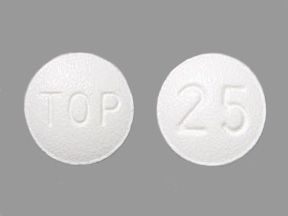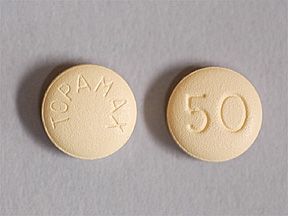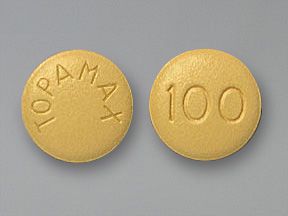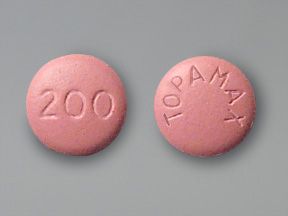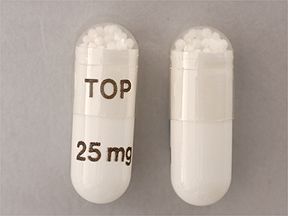Topamax is usually taken twice per day. The exact dosage varies depending on the condition it’s being used to treat.
Topamax (topiramate) is used in adults and certain children ages 2 years and older to treat:
- primary generalized tonic-clonic seizures
- focal onset seizures (also known as partial seizures and partial onset seizures)
- seizures caused by Lennox-Gastaut syndrome (a rare condition that affects children)
Topamax is also used to help prevent migraine headaches in adults and children ages 12 years and older.
Topamax belongs to a group of drugs called anticonvulsants.
This article describes the dosages of Topamax, as well as its strengths and how to take it. To learn more about this drug, see this in-depth Topamax article.
The following table highlights the basics of Topamax’s dosage. All doses are listed in milligrams (mg).
Before starting your maintenance (ongoing) dosage, your doctor will start you on a low Topamax dosage. They’ll adjust it over time to reach the right amount for you.
| Condition | Adult maintenance dosage |
|---|---|
| seizures, when Topamax is taken by itself (without other seizure drugs) | 200 mg in the morning and 200 mg in the evening (400 mg total) |
| seizures, when Topamax is taken with other seizure drugs | • focal onset seizures and seizures linked to Lennox-Gastaut syndrome: 100–200 mg in the morning and 100–200 mg in the evening (200–400 mg total) • generalized tonic-clonic seizures: 200 mg in the morning and 200 mg in the evening (400 mg total) |
| migraine prevention | 50 mg in the morning and 50 mg in the evening (100 mg total) |
In some cases, doctors may adjust your dosage from those shown here, such as if you have kidney problems or other health conditions.
Topamax forms
Topamax comes in two forms:
- coated tablets that you swallow
- sprinkle capsules that you can either swallow whole or open, or sprinkle on a small amount of soft food and swallow
Topamax strengths
Topamax tablets come in four strengths: 25 mg, 50 mg, 100 mg, and 200 mg.
Topamax sprinkle capsules come in two strengths: 15 mg and 25 mg.
The recommended dosage of Topamax for migraine prevention is 50 mg taken two times per day.
Your doctor will have you start your treatment by taking 25 mg once daily for 1 week to see how your body reacts to the drug. Then, they’ll gradually increase your dose each week for 4 weeks until you reach the maximum dosage. The maximum dosage of Topamax is 50 mg taken twice per day.
Below is the typical dosage schedule for migraine prevention:
- Week 1: 25 mg in the evening
- Week 2: 25 mg in the morning and 25 mg in the evening
- Week 3: 25 mg in the morning and 50 mg in the evening
- Week 4: 50 mg in the morning and 50 mg in the evening
Slowly increasing your Topamax dosage over several weeks allows your doctor to see how well you tolerate the drug. It also helps your body get used to the medication. Your doctor may increase your dosage even more slowly if you experience side effects.
This dosage is commonly recommended, but be sure to take the dosage your doctor prescribes for you.
Your dosage for treating seizures will depend on whether you take Topamax by itself or with other drugs. The following dosages are commonly recommended, but be sure to take the dosage your doctor prescribes for you.
Topamax dosage when used alone for seizures
Topamax can be used on its own to treat focal onset seizures and generalized tonic-clonic seizures.
When taken alone, the maximum Topamax dosage for seizures is 200 mg taken twice per day for a total of 400 mg daily. You’ll take one dose in the morning and one in the evening.
Your doctor will start by prescribing the lowest dose of Topamax and slowly increasing your dose until you reach the maximum recommended dosage.
Below is the typical dosage schedule for treating seizures:
- Week 1: 25 mg in the morning and 25 mg in the evening
- Week 2: 50 mg in the morning and 50 mg in the evening
- Week 3: 75 mg in the morning and 75 mg in the evening
- Week 4: 100 mg in the morning and 100 mg in the evening
- Week 5: 150 mg in the morning and 150 mg in the evening
- Week 6: 200 mg in the morning and 200 mg in the evening
Topamax dosage when used with other seizure drugs
Topamax may be used with other medications to treat focal onset seizures, generalized tonic-clonic seizures, or seizures linked to Lennox-Gastaut syndrome.
During the first week of treatment, your doctor will start by prescribing a low dose, such as 25–50 mg per day. This will allow your doctor to see how your body reacts to the drug. Then, they’ll gradually increase your dose over several weeks until you reach the dose that’s right for you. The maximum recommended dosage is 400 mg per day.
- For focal onset seizures and seizures linked to Lennox-Gastaut syndrome, the recommended dosage is 200–400 mg per day. This is taken in two doses: one in the morning and one in the evening.
- For generalized tonic-clonic seizures, the dosage is 200 mg taken twice per day. This means you’ll take a total of 400 mg per day. You’ll usually take one dose in the morning and one in the evening.
The Topamax dosage for children depends on the condition being treated, your child’s age, and their body weight.
Children’s dosage for migraine
Topamax’s dosage to help prevent migraine headaches in children ages 12 years and older is the same as it is for adults. See the “Topamax dosage for migraine” section for details.
Children’s dosage for seizures
For treating seizures, the dosage for children depends on whether Topamax is prescribed alone or with other drugs.
Topamax dosage when used alone in children ages 2–9 years
For children ages 2–9 years, Topamax dosing is based on weight.
The starting dosage is 25 mg taken in the evening for 1 week. If your child tolerates this dosage, the Topamax dosage is increased to 25 mg taken twice per day for 1 week. After this, the dosage is gradually increased by 25–50 mg over several weeks until the maximum dosage for their weight is reached. The dose is increased gradually to lower the risk of side effects with the drug.
The table below shows the recommended dosage of Topamax based on your child’s weight in kilograms (kg). For reference, 1 kg equals about 2.2 pounds (lb).
| Weight | Daily maintenance dosage, divided into two doses (morning and evening) |
|---|---|
| up to 11 kg (about 24 lb) | 150–250 mg |
| 12–22 kg (about 26–49 lb) | 200–300 mg |
| 23–31 kg (about 50–68 lb) | 200–350 mg |
| 32–38 kg (about 70–84 lb) | 250–350 mg |
| greater than 38 kg (about 84 lb) | 250–400 mg |
The maximum recommended dose is 400 mg per day. Your child’s doctor will determine what their dose should be based on their weight in kg.
Topamax dosage when used alone in children ages 10 years and older
For treating focal onset and generalized tonic-clonic seizures in children ages 10 years and older, the dosage is the same for children as it is for adults. See the “Topamax dosages for seizures” section for details.
Topamax dosage for children when used with other seizure drugs
The dosage of Topamax when used with other medications for seizures in children ages 2–16 years is based on body weight, as follows. (The dosage for children ages 17 years and older is the same as it is for adults. See the “Topamax dosages for seizures” section for details.)
- The starting dosage is 1–3 mg per kg of body weight (mg/kg) daily for the first week of treatment, up to 25 mg per day. This is taken as one dose per day, in the evening.
- Then, the dosage is gradually increased by 1–3 mg/kg per day every 1–2 weeks. The daily dose is split into two doses, taken once in the morning and once in the evening. The dosage will be increased until the right dosage for your child is reached.
- The recommended maintenance dosage is 5–9 mg/kg per day. The daily dose is divided into two doses, given in the morning and evening.
- The maximum recommended dosage is 400 mg per day.
Do not take more Topamax than your doctor prescribes. Taking more than this can lead to serious side effects.
Symptoms of overdose
Symptoms caused by an overdose can include:
- drowsiness
- blurred vision
- convulsions
- slurred speech
- dizziness
- agitation
- stupor (not being alert to your surroundings)
- low blood pressure
- difficulty with coordination
- abdominal pain
What to do in case you take too much Topamax
Call your doctor right away if you think you’ve taken too much Topamax. You can also call 800-222-1222 to reach America’s Poison Centers, or you can use its online resource. But if you have severe symptoms, call 911 (or your local emergency number) immediately or go to the nearest emergency room.
Below are answers to some common questions about Topamax’s dosage.
What’s the maximum dose of Topamax for weight loss?
There is not an approved dosage of Topamax for weight loss, since the drug isn’t approved by the FDA for this use. But in some cases, your doctor may prescribe it off-label for this use. (With off-label use, doctors prescribe a drug for a purpose other than what it’s approved for.)
If your doctor prescribes Topamax for weight loss, they’ll recommend the best dosage for you. Topamax’s maximum dosages are 100 mg per day for migraine prevention and 400 mg per day for seizures.
Be sure to take the dosage your doctor prescribes for you.
Is Topamax used to treat bipolar disorder or depression?
Topamax is not approved for bipolar disorder or depression. But in some cases, your doctor may prescribe it off-label for one of these uses.
Because Topamax isn’t approved for these conditions, the drug manufacturer doesn’t provide recommended dosages for them. Your doctor will prescribe the dosage that’s right for you.
To learn more about your treatment options for these conditions, including Topamax, talk with your doctor. You can also read this article about treatment options for depressive bipolar episodes.
Can Topamax be prescribed to reduce alcohol cravings?
It depends. Topamax is not approved to reduce alcohol cravings. But it’s possible for doctors to prescribe it off-label for this use.
Since Topamax isn’t approved to reduce alcohol cravings, the drug’s manufacturer does not recommend specific dosages for this use. If your doctor prescribes Topamax for your condition, they’ll prescribe the dosage that’s right for you.
For details about how Topamax may help reduce alcohol cravings, talk with your doctor.
The dosage of Topamax you’re prescribed may depend on several factors. These include:
- the type and severity of the condition you’re using Topamax to treat
- your age
- your weight
- other conditions you may have, such as problems with your kidney function
- if you’re taking other medications with Topamax
Topamax comes in two forms:
- coated tablets that you swallow
- sprinkle capsules that you can swallow whole or open and sprinkle on a small amount of soft food and swallow
You can take either form with or without food.
You should not crush, split, or chew the Topamax tablets because they have a bitter taste. If you have trouble swallowing, your doctor may prescribe the sprinkle capsules.
You can open the sprinkle capsules and mix the contents with a small amount of soft food. It’s important to swallow this mixture without chewing. Then, you should drink fluids to make sure that you swallow the entire dose.
Is Topamax used long term?
Yes, Topamax is typically taken as a long-term treatment. If you and your doctor determine that Topamax is safe and effective for you, it’s likely that you’ll take it long term.
What if I miss a dose?
If you miss a dose of Topamax, you can take it when you remember as long as there are 6 hours or more until your next scheduled dose. If there are fewer than 6 hours until your next dose, just skip the missed dose and take the next dose at its regular time. You should not take two doses of Topamax together to make up for a missed dose. This can raise your risk of serious side effects.
If you need help remembering to take your dose of Topamax on time, try using a medication reminder. This can include setting an alarm or using a timer. You could also download a reminder app on your phone.
No studies have looked at whether Topamax can cause drug dependence, so it’s not known if this can occur. (With dependence, your body needs the drug to function as usual.)
But you should not suddenly stop taking Topamax. Suddenly stopping your treatment can lead to your seizures or migraine symptoms becoming more severe or occurring more often.
If you’re experiencing side effects from Topamax, talk with your doctor about your treatment options. And if you need to stop taking Topamax, your doctor may slowly decrease your dosage. This helps prevent serious side effects and worsening of your condition.
Q:
Will Topamax still work if I’m taking a lower dosage than what’s recommended for my condition?
AnonymousA:
Depending on other medications you take or other medical conditions you have, your doctor may prescribe a lower dosage of Topamax. Even at a lower dosage, Topamax should still be effective at treating your condition.
In addition, your doctor will prescribe a lower dosage when you’re first starting your Topamax treatment. Then, they’ll increase the dosage over time, which helps reduce your risk of side effects.
If you feel like Topamax isn’t effectively treating your condition, or if you have questions about the dosage that’s right for you, talk with your doctor.
The Healthline Pharmacist TeamAnswers represent the opinions of our medical experts. All content is strictly informational and should not be considered medical advice.Disclaimer: Healthline has made every effort to make certain that all information is factually correct, comprehensive, and up to date. However, this article should not be used as a substitute for the knowledge and expertise of a licensed healthcare professional. You should always consult your doctor or another healthcare professional before taking any medication. The drug information contained herein is subject to change and is not intended to cover all possible uses, directions, precautions, warnings, drug interactions, allergic reactions, or adverse effects. The absence of warnings or other information for a given drug does not indicate that the drug or drug combination is safe, effective, or appropriate for all patients or all specific uses.





